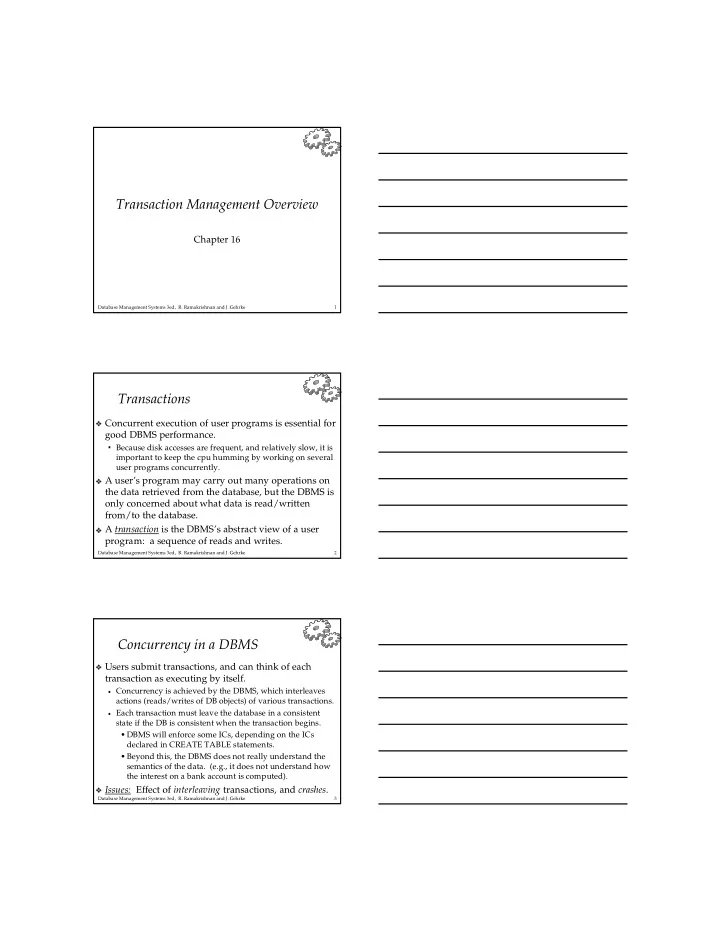

✁ ✁ � ✁ � � � � Transaction�Management�Overview Chapter�16 Database�Management�Systems�3ed,��R.�Ramakrishnan�and�J.�Gehrke 1 Transactions Concurrent�execution�of�user�programs�is�essential�for� good�DBMS�performance. Because�disk�accesses�are�frequent,�and�relatively�slow,�it�is� important�to�keep�the�cpu�humming�by�working�on�several� user�programs�concurrently. A�user’s�program�may�carry�out�many�operations�on� the�data�retrieved�from�the�database,�but�the�DBMS�is� only�concerned�about�what�data�is�read/written� from/to�the�database. A� transaction is�the�DBMS’s�abstract�view�of�a�user� program:��a�sequence�of�reads�and�writes. Database�Management�Systems�3ed,��R.�Ramakrishnan�and�J.�Gehrke 2 Concurrency�in�a�DBMS Users�submit�transactions,�and�can�think�of�each� transaction�as�executing�by�itself. Concurrency�is�achieved�by�the�DBMS,�which�interleaves� actions�(reads/writes�of�DB�objects)�of�various�transactions. Each�transaction�must�leave�the�database�in�a�consistent� state�if�the�DB�is�consistent�when�the�transaction�begins. • DBMS�will�enforce�some�ICs,�depending�on�the�ICs� declared�in�CREATE�TABLE�statements. • Beyond�this,�the�DBMS�does�not�really�understand�the� semantics�of�the�data.��(e.g.,�it�does�not�understand�how� the�interest�on�a�bank�account�is�computed). Issues: Effect�of� interleaving transactions,�and� crashes . Database�Management�Systems�3ed,��R.�Ramakrishnan�and�J.�Gehrke 3
� � � � � ✁ � � � Atomicity�of�Transactions A�transaction�might commit after�completing�all�its� actions,�or�it�could� abort (or�be�aborted�by�the�DBMS)� after�executing�some�actions. A�very�important�property�guaranteed�by�the�DBMS� for�all�transactions�is�that�they�are� atomic . That�is,�a� user�can�think�of�a�Xact�as�always�executing�all�its� actions�in�one�step,�or�not�executing�any�actions�at�all. DBMS� logs all�actions�so�that�it�can� undo the�actions�of� aborted�transactions. Database�Management�Systems�3ed,��R.�Ramakrishnan�and�J.�Gehrke 4 Example Consider�two�transactions�( Xacts ): T1: BEGIN���A=A+100,���B=B-100���END T2: BEGIN���A=1.06*A,���B=1.06*B���END Intuitively,�the�first�transaction�is�transferring�$100� from�B’s�account�to�A’s�account.��The�second�is� crediting�both�accounts�with�a�6%�interest�payment. There�is�no�guarantee�that�T1�will�execute�before�T2�or� vice-versa,�if�both�are�submitted�together.��However,� the�net�effect� must� be�equivalent�to�these�two� transactions�running�serially�in�some�order. Database�Management�Systems�3ed,��R.�Ramakrishnan�and�J.�Gehrke 5 Example�(Contd.) Consider�a�possible�interleaving�( schedule ): T1: A=A+100,��� B=B-100��� T2: A=1.06*A,�� B=1.06*B This�is�OK.��But�what�about: T1: A=A+100,��� B=B-100��� T2: A=1.06*A,�B=1.06*B The�DBMS’s�view�of�the�second�schedule: T1: R(A),�W(A),��� R(B),�W(B) T2: R(A),�W(A),�R(B),�W(B) Database�Management�Systems�3ed,��R.�Ramakrishnan�and�J.�Gehrke 6
� � � � � � Scheduling�Transactions Serial�schedule: Schedule�that�does�not�interleave�the� actions�of�different�transactions. Equivalent�schedules : For�any�database�state,�the�effect� (on�the�set�of�objects�in�the�database)�of�executing�the� first�schedule�is�identical�to�the�effect�of�executing�the� second�schedule. Serializable�schedule :��A�schedule�that�is�equivalent�to� some�serial�execution�of�the�transactions. (Note:�If�each�transaction�preserves�consistency,�every� serializable�schedule�preserves�consistency.�) Database�Management�Systems�3ed,��R.�Ramakrishnan�and�J.�Gehrke 7 Anomalies�with�Interleaved�Execution Reading�Uncommitted�Data�(WR�Conflicts,� “dirty�reads”): T1:� R(A),�W(A),��� R(B),�W(B),�Abort T2: R(A),�W(A),�C Unrepeatable�Reads�(RW�Conflicts): T1: R(A),�� R(A),�W(A),�C T2: R(A),�W(A),�C Database�Management�Systems�3ed,��R.�Ramakrishnan�and�J.�Gehrke 8 Anomalies�(Continued) Overwriting�Uncommitted�Data�(WW� Conflicts): T1: W(A),�� W(B),�C T2: W(A),�W(B),�C Database�Management�Systems�3ed,��R.�Ramakrishnan�and�J.�Gehrke 9
✁ � � ✁ ✁ � � � � � � ✁ ✁ ✁ � Lock-Based�Concurrency�Control Strict�Two-phase�Locking�(Strict�2PL)�Protocol : Each�Xact�must�obtain�a�S�( shared )�lock�on�object�before� reading,�and�an�X�( exclusive )�lock�on�object�before�writing. All�locks�held�by�a�transaction�are�released�when�the� transaction�completes If�an�Xact�holds�an�X�lock�on�an�object,�no�other�Xact�can� get�a�lock�(S�or�X)�on�that�object. Strict�2PL�allows�only�serializable�schedules. Database�Management�Systems�3ed,��R.�Ramakrishnan�and�J.�Gehrke 10 Aborting�a�Transaction If�a�transaction� Ti is�aborted,�all�its�actions�have�to�be� undone.��Not�only�that,�if� Tj� reads�an�object�last� written�by� Ti ,�� Tj must�be�aborted�as�well! Most�systems�avoid�such� cascading�aborts by�releasing� a�transaction’s�locks�only�at�commit�time. If� Ti writes�an�object,� Tj can�read�this�only�after� Ti commits. In�order�to� undo the�actions�of�an�aborted�transaction,� the�DBMS�maintains�a� log in�which�every�write�is� recorded.��This�mechanism�is�also�used�to�recover� from�system�crashes:��all�active�Xacts�at�the�time�of�the� crash�are�aborted�when�the�system�comes�back�up. Database�Management�Systems�3ed,��R.�Ramakrishnan�and�J.�Gehrke 11 The�Log The�following�actions�are�recorded�in�the�log: Ti�writes�an�object :��the�old�value�and�the�new�value. • Log�record�must�go�to�disk before the�changed�page! Ti�commits/aborts :��a�log�record�indicating�this�action. Log�records�are�chained�together�by�Xact�id,�so�it’s� easy�to�undo�a�specific�Xact. Log�is�often� duplexed� and� archived on�stable�storage. All�log�related�activities�(and�in�fact,�all�CC�related� activities�such�as�lock/unlock,�dealing�with�deadlocks� etc.)�are�handled�transparently�by�the�DBMS. Database�Management�Systems�3ed,��R.�Ramakrishnan�and�J.�Gehrke 12
� � � ✁ ✁ � ✁ ✁ ✁ Recovering�From�a�Crash There�are�3�phases�in�the� Aries recovery�algorithm: Analysis :��Scan�the�log�forward�(from�the�most�recent� checkpoint )�to�identify�all�Xacts�that�were�active,�and�all�dirty� pages�in�the�buffer�pool�at�the�time�of�the�crash. Redo :��Redoes�all�updates�to�dirty�pages�in�the�buffer�pool,� as�needed,�to�ensure�that�all�logged�updates�are�in�fact� carried�out�and�written�to�disk. Undo :��The��writes�of�all�Xacts�that�were�active�at�the�crash� are�undone�(by�restoring�the� before�value� of�the�update,� which�is�in�the�log�record�for�the�update),�working� backwards�in�the�log.��(Some�care�must�be�taken�to�handle� the�case�of�a�crash�occurring�during�the�recovery�process!) Database�Management�Systems�3ed,��R.�Ramakrishnan�and�J.�Gehrke 13 Summary Concurrency�control�and�recovery�are�among�the� most�important�functions�provided�by�a�DBMS. Users�need�not�worry�about�concurrency. System�automatically�inserts�lock/unlock�requests�and� schedules�actions�of�different�Xacts�in�such�a�way�as�to� ensure�that�the�resulting�execution�is�equivalent�to� executing�the�Xacts�one�after�the�other�in�some�order. Write-ahead�logging�(WAL)�is�used�to�undo�the� actions�of�aborted�transactions�and�to�restore�the� system�to�a�consistent�state�after�a�crash. Consistent�state :��Only�the�effects�of�commited�Xacts�seen. Database�Management�Systems�3ed,��R.�Ramakrishnan�and�J.�Gehrke 14
Recommend
More recommend